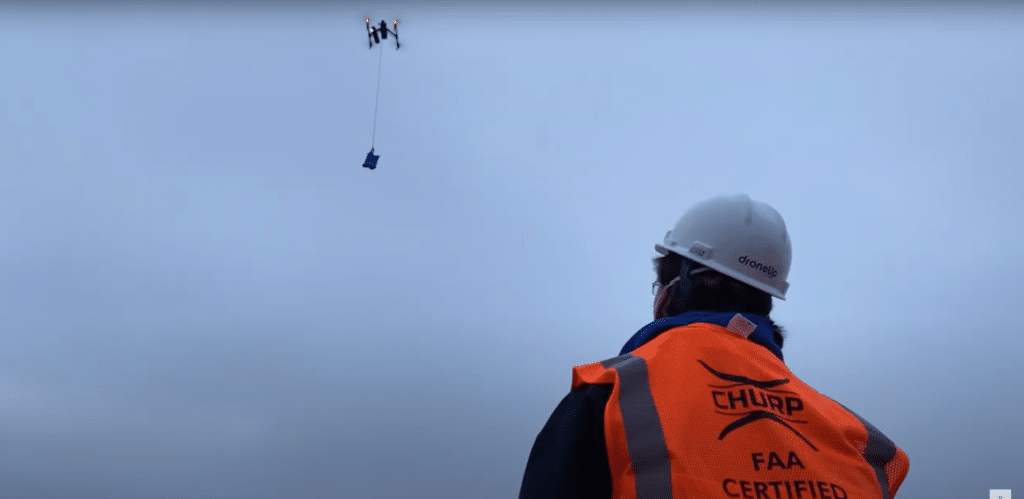COVID-Fighting Collaboration Proves Potential of UAS for Test Transport
February 10, 2021 | Amy French

Exercise in upstate N.Y. shows how flight could replace drives through downtown traffic.
A team of more than a dozen COVID-19-motivated entities with expertise in public health, public safety and unmanned flight recently enjoyed a hard-won peek into the future of UAS in medical transport in upstate New York.
The peek included roughly 15 flights, including a media demonstration, in January to prove the ability to move COVID test kits between the State University of New York’s Upstate University Hospital and the hospital’s diagnostics lab in the Central New York Biotech Accelerator. The facilities are fewer than 1,000 yards apart by air, officials estimated, but the hospital has long relied on automotive transport back and forth across about seven blocks of 30-mph traffic in downtown Syracuse.
Dr. Robert Corona, chief executive officer of Upstate University Hospital, said he was so excited that he felt like a kid as he watched the demonstration Jan. 16. Corona said his enthusiasm for flight goes back to his teens, when he learned to pilot small planes, and his enthusiasm for UAS as a potential means of medical transport also goes back years.
“This was a wild dream of mine from back in my days as pathology chair,” said Corona, laughing as he recalled the looks of doubt he used to get when describing his hopes to hospital colleagues. “We are grateful that CHURP chose Syracuse and the SUNY system to validate this vital technology.”
Standing beside Corona at the demonstration was Tony Basile, chief operating officer of NUAIR, a nonprofit that manages the New York UAS Test Site at Griffiss International Airport. The hospital and NUAIR were key players on the wide-ranging team that spent most of 2020 orchestrating the proof-of-concept exercise – a team dubbed the COVID-19 Humanitarian UAS Response Partnership, or CHURP.
While the flights were short, the preparation required was long and complicated, Basile emphasized. He praised CHURP’s founders, the international law firm Akin Gump Strauss Hauer & Feld and Jacksonville, Fla.-based Emergent 121 Consulting, for their role in facilitating the effort.
CHURP got underway in early spring, as New Rochelle, N.Y., reeled from the shock of being an early epicenter of the pandemic.
“Once we got going, we would have three phone calls a week,” Basile said. “With each week’s phone call, there would be one or two new entities on board – and there were, you know, some very big names, contributing ideas.”
Participation was especially strong, Basile said, because while the potential for UAS to streamline medical transport is widely recognized, the actual use of unmanned aircraft for that purpose has been slow to take off. Examples of progress have arisen in Maryland, where a kidney for transplant was delivered by UAS to the University of Maryland School of Medicine; and in North Carolina, where WakeMed Health and Hospitals uses drones to transport medical samples.
But each leap forward in a new location has required years of groundwork.
Regulatory complexities that CHURP dealt with, Basile said, included the need for an FAA waiver to fly over people and moving vehicles, a waiver that has since become unnecessary for flights within the parameters of an FAA rule finalized in December. Another tricky area, he said, involved restrictions on the transport of hazardous materials. Those restrictions ultimately led CHURP to test only the transport of unused COVID test kits.Preparation also included pilot training, which was handled by DroneUp. Pilots flew DJI Inspire small quads with Indemnis parachutes, and carried payloads of a pound or less at the end of an 8-foot tether, Basile said. Lessons dealt with such matters as handling the tethered setup, as well as avoiding conflicts with air ambulance flights.
There are no immediate plans to use UAS to transport COVID-19 tests routinely, Basile said. But enthusiasm about the success of the exercise has CHURP team members looking beyond COVID for ways to use UAS. Possibilities under discussion, Basile said, include the transport of tissue samples and medication.
“The ability to quickly and safely transport pharmaceutical items is a game-changer,” he said. “In the healthcare world, where every minute counts, the collaborative work we’ve done here showcases the viability, economic advantages, and life-saving potential of contactless drone deliveries.”
- Industry News


